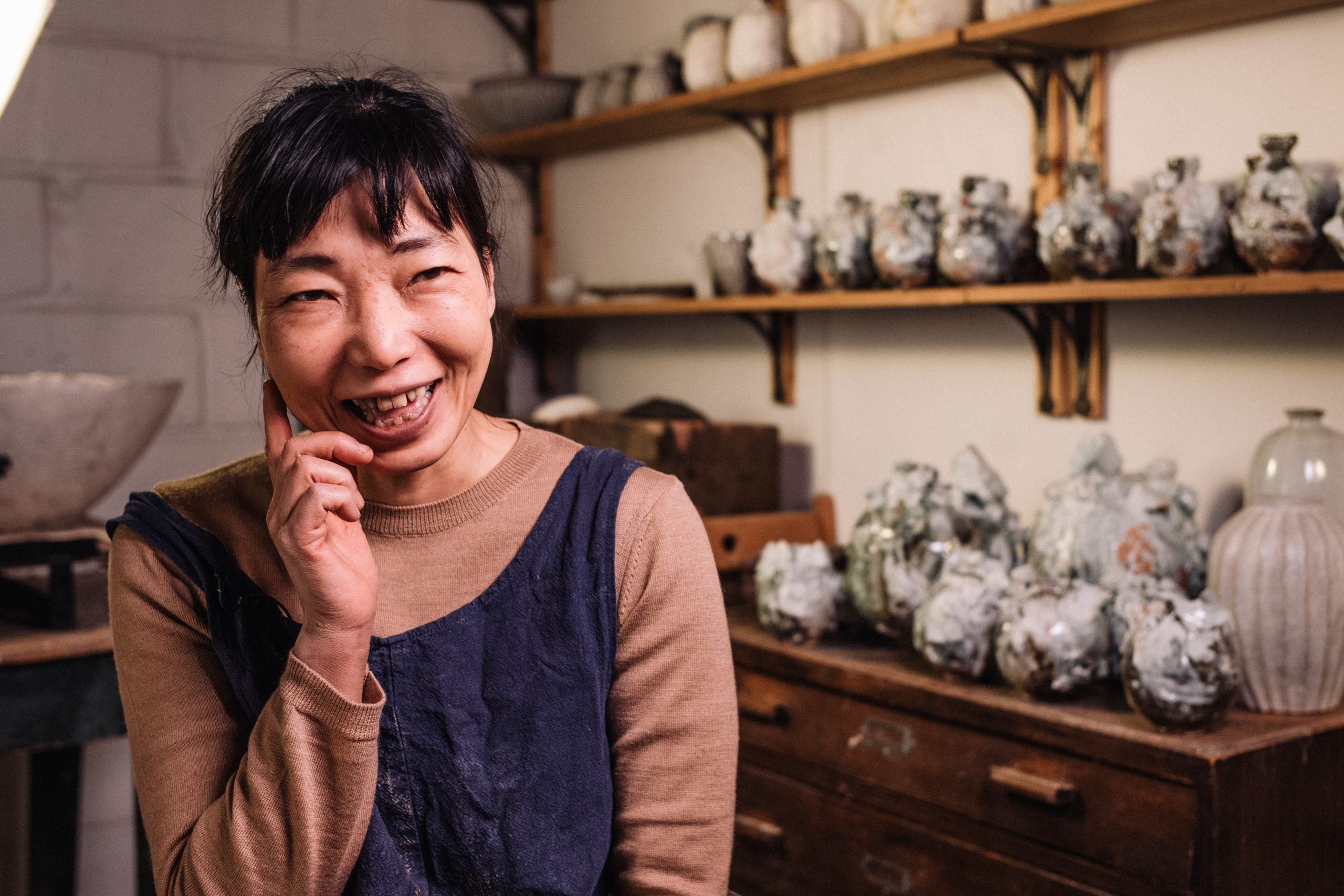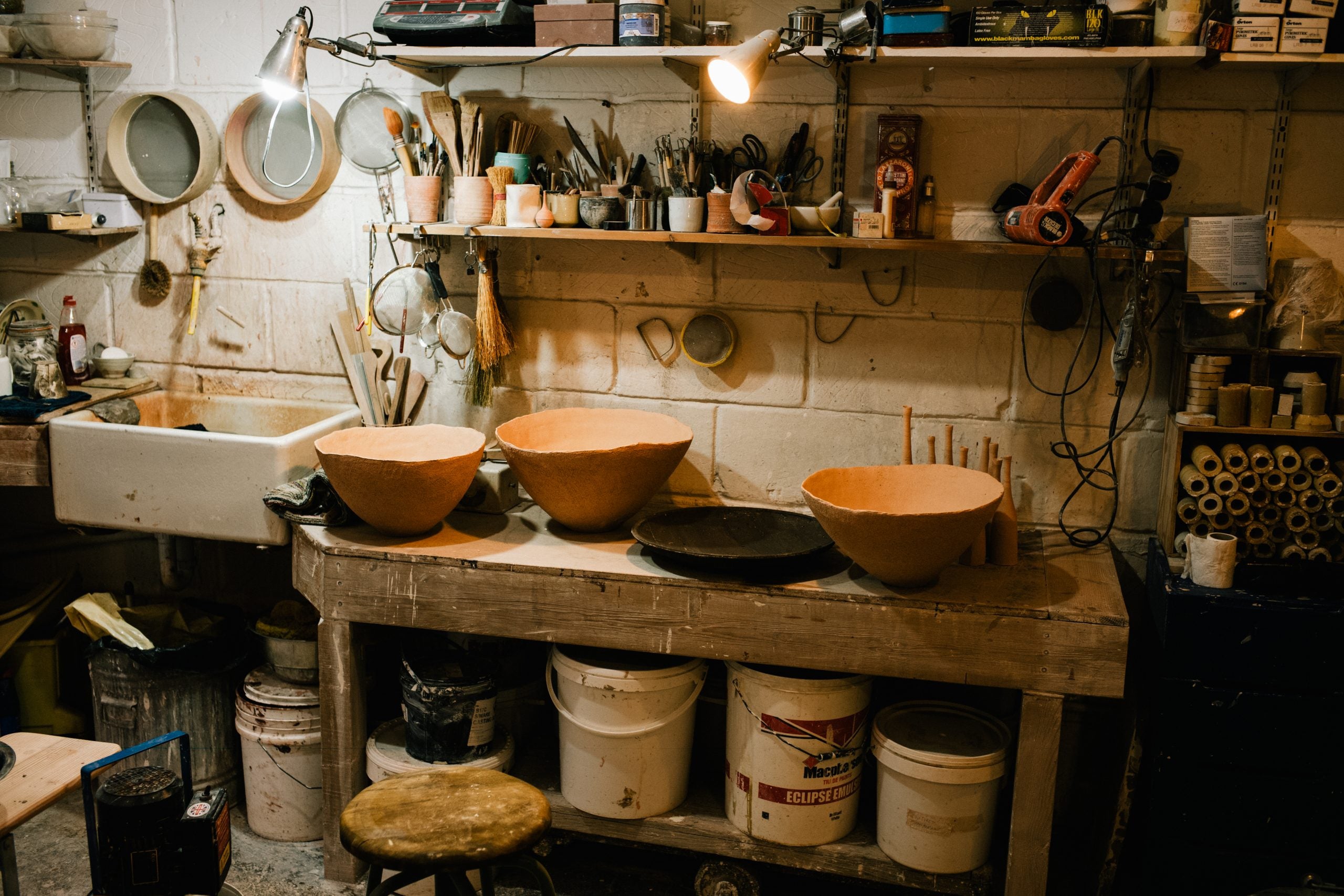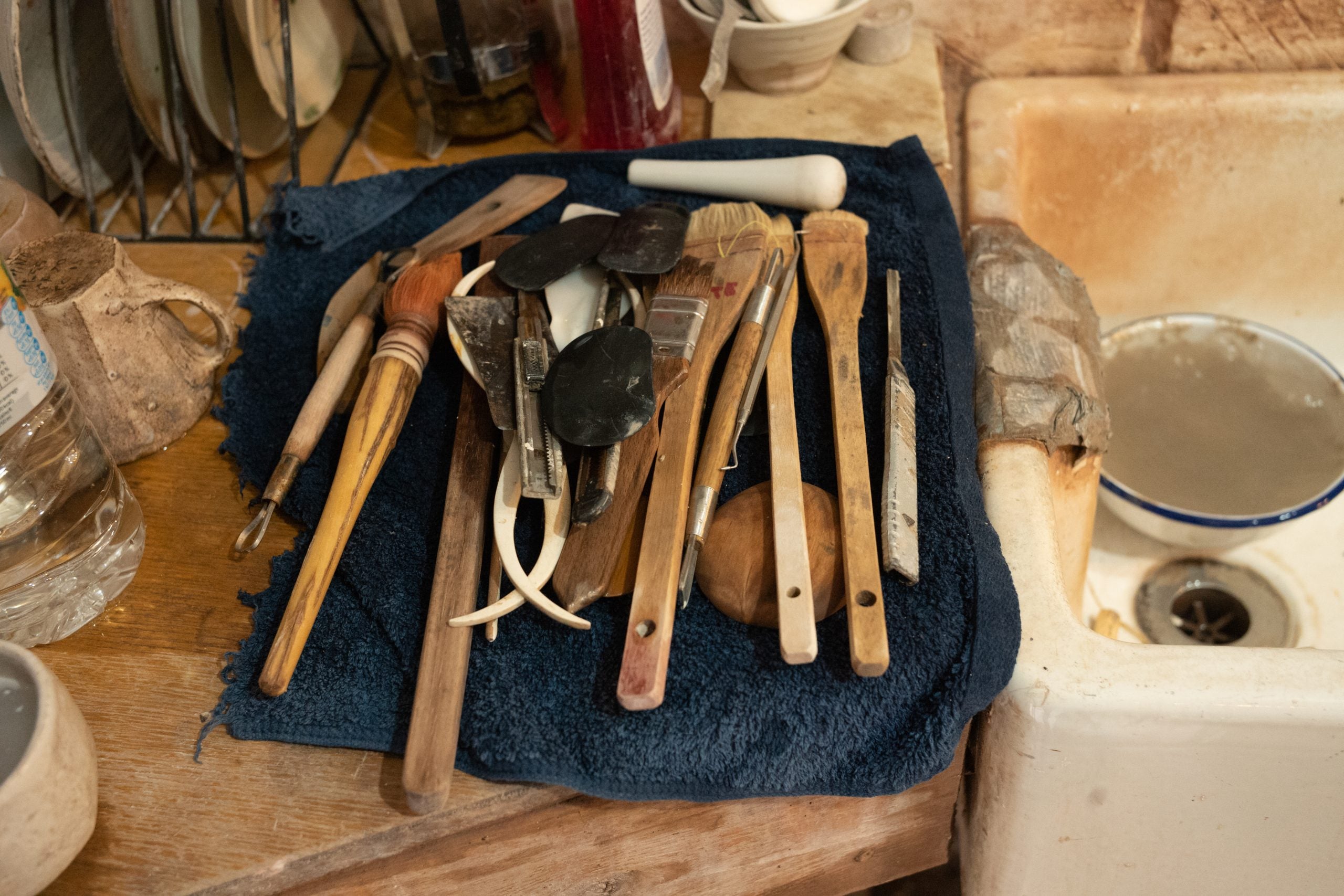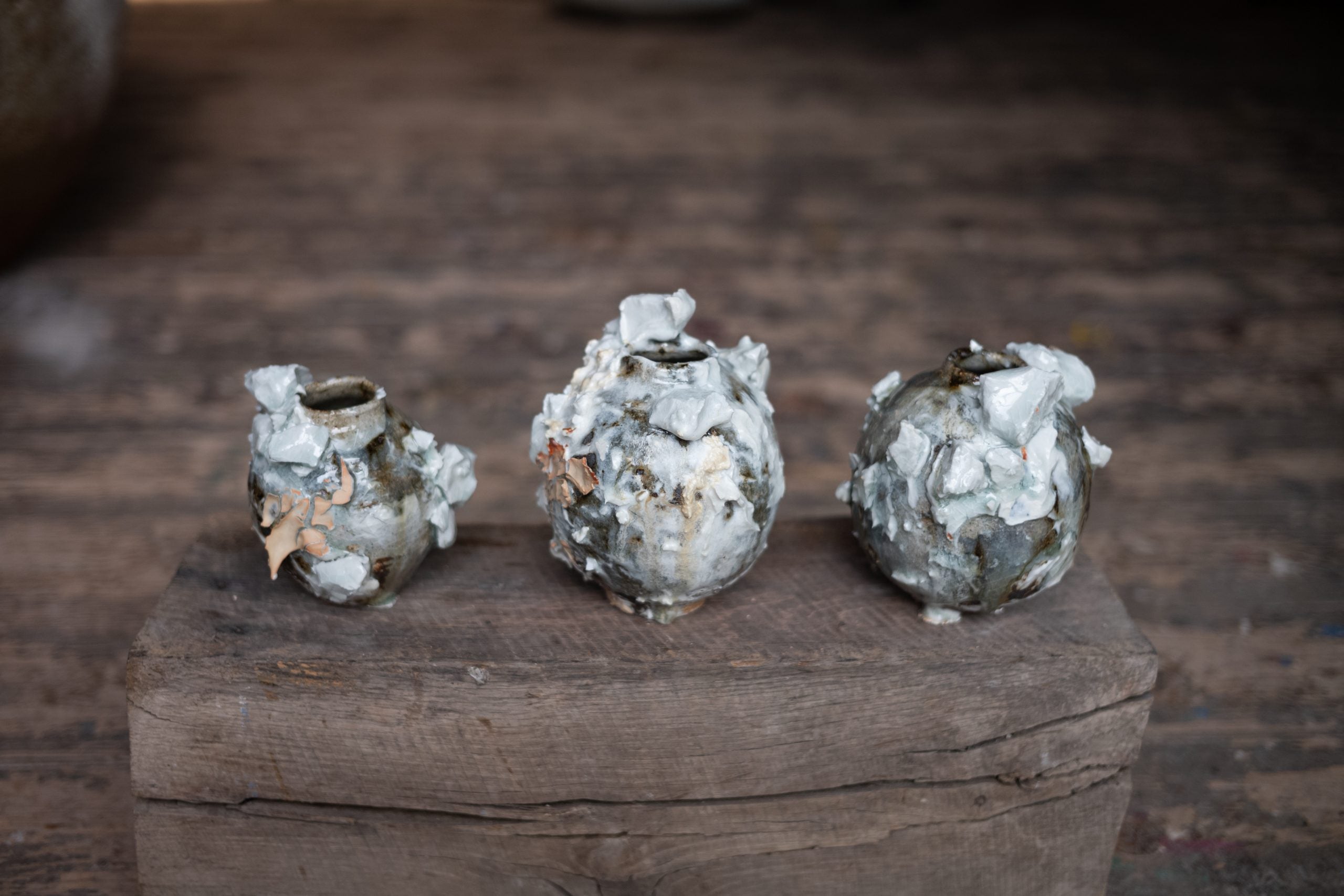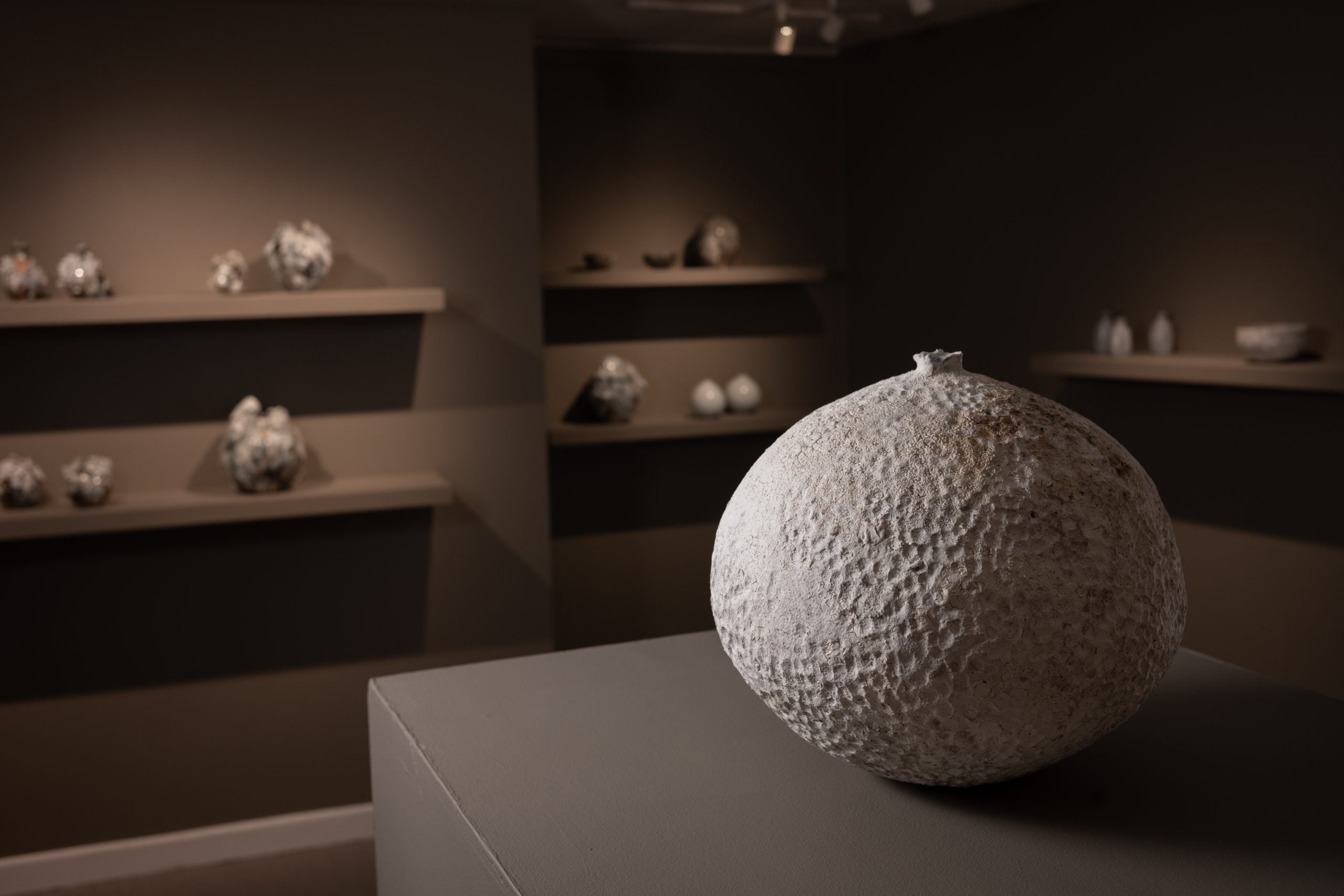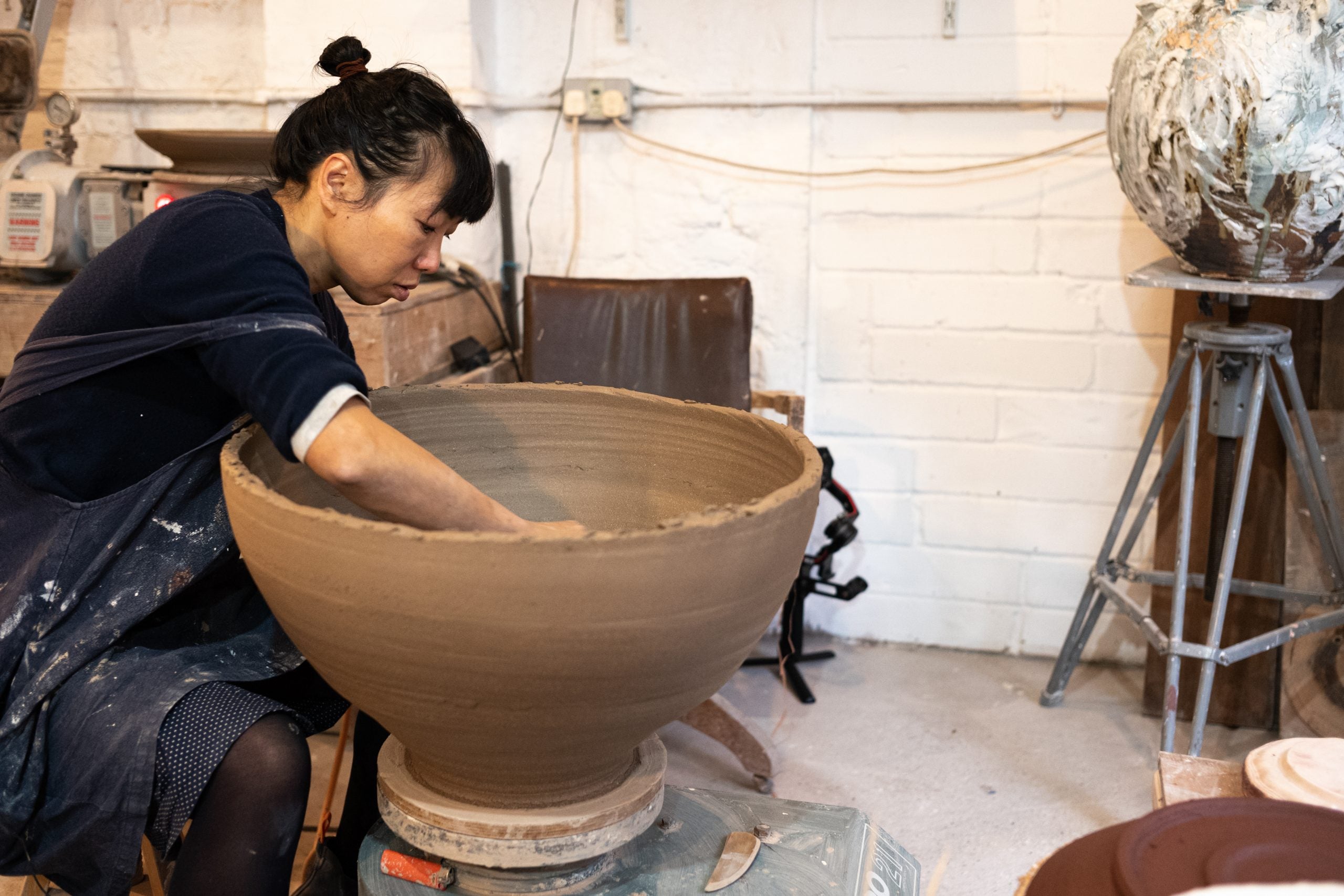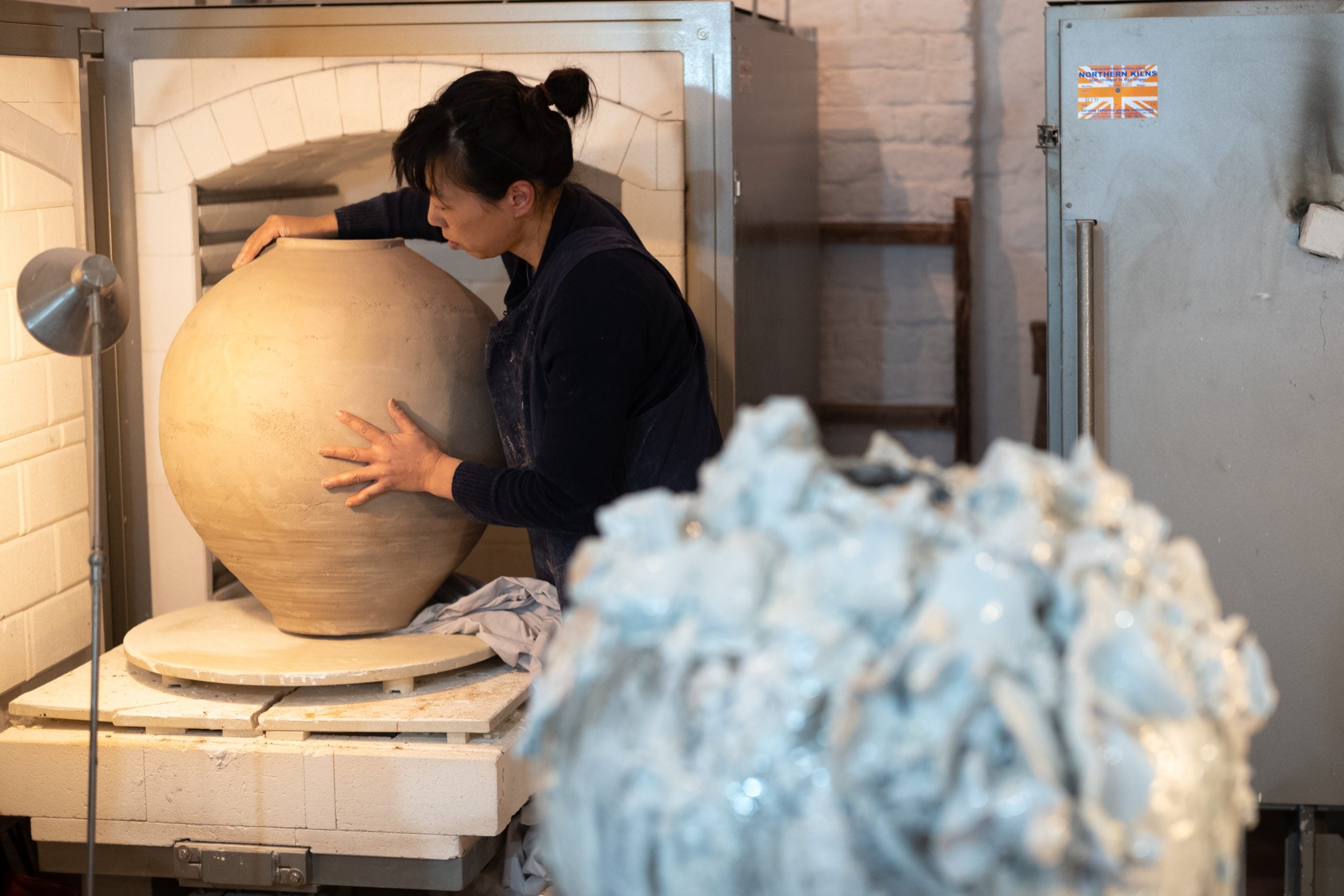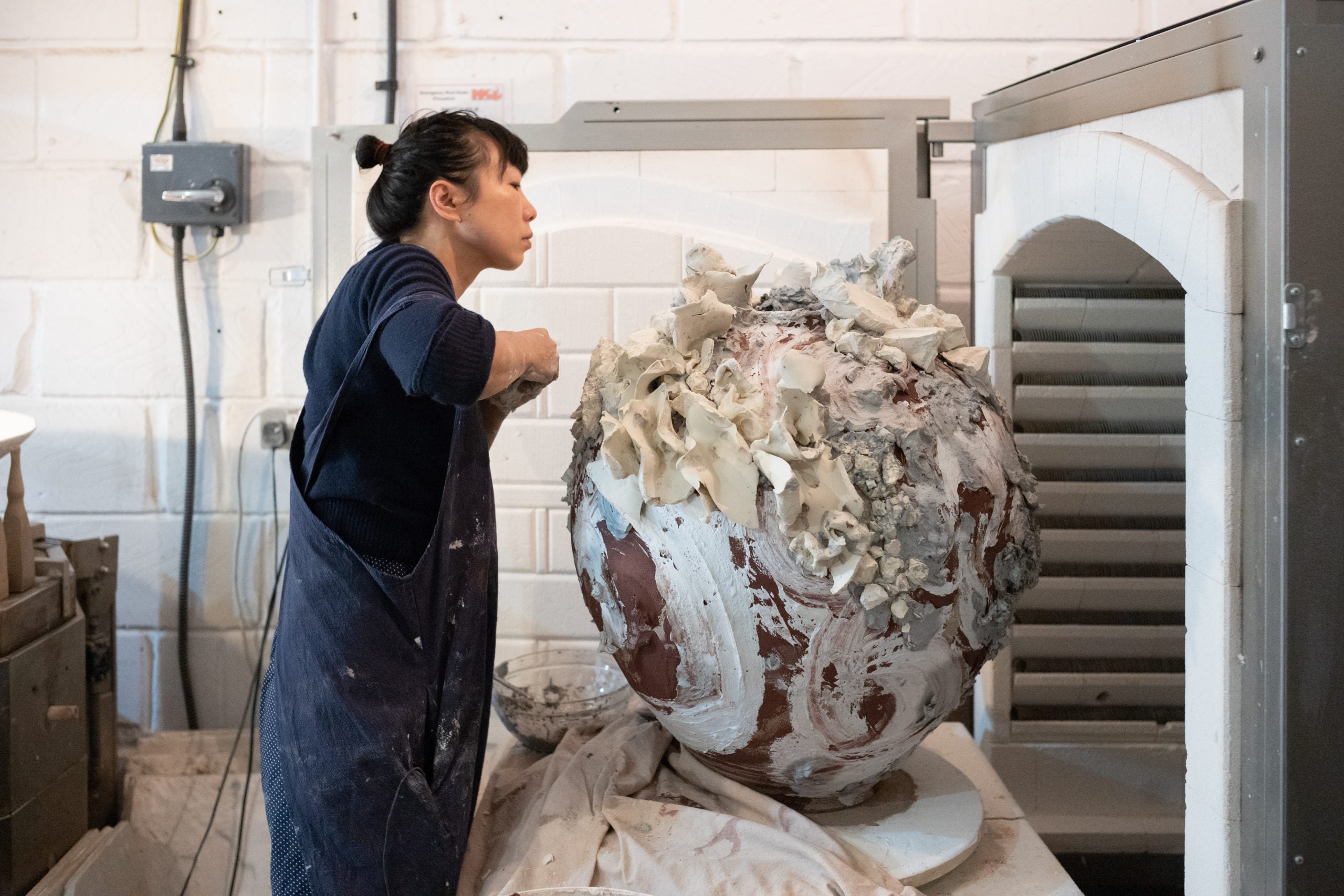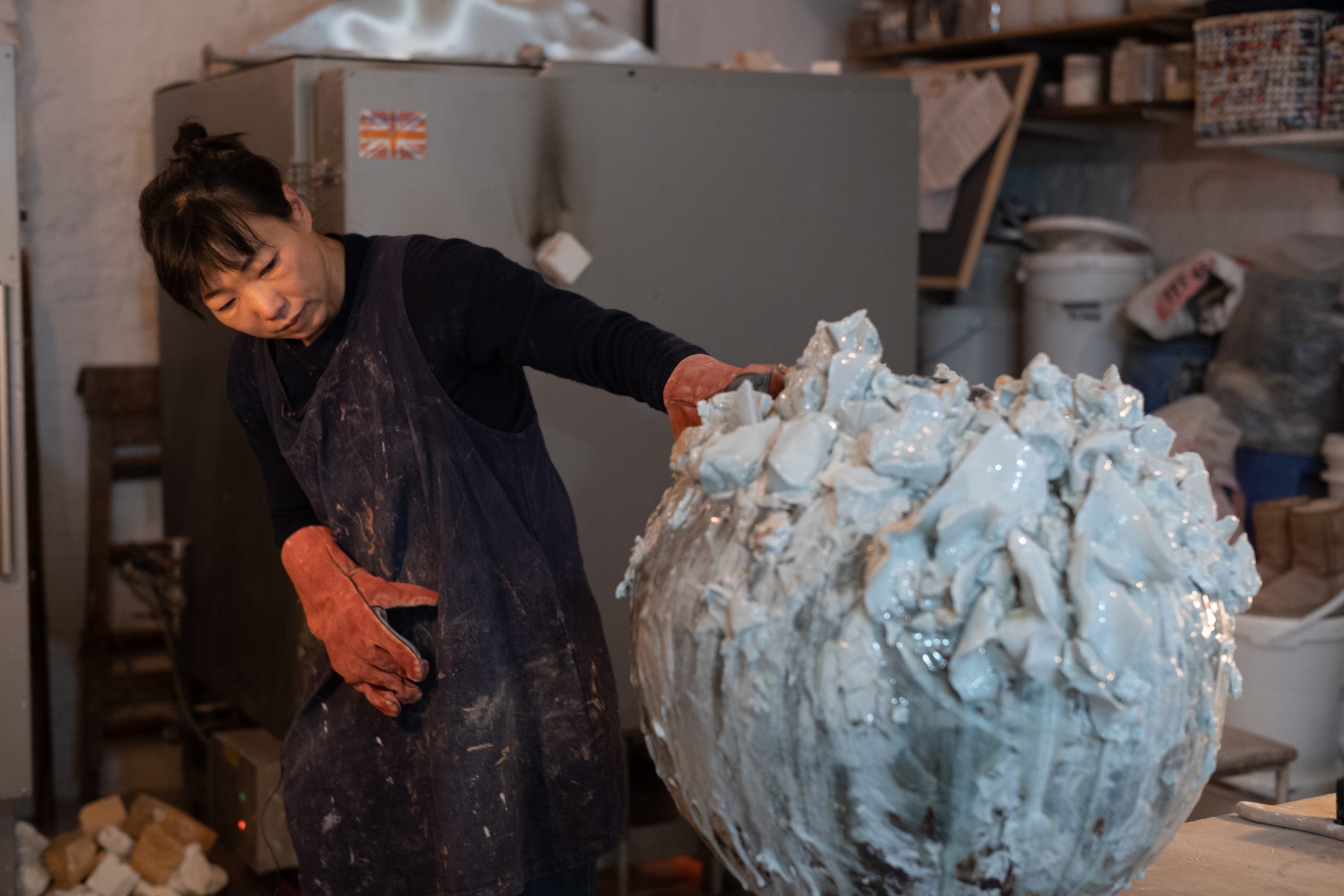My pots display a lot of marks and traces of past events. To describe them in a conventional and very simplified way, they are ‘dirty’ and ‘broken’. On the other hand, they can be described in a more sophisticated way as wabi-sabi, which refers to the beauty of imperfection and impermanence.
Akiko Hirai photographed in her studio by Jay Goldmark
I graduated from my university ceramics course here in the UK in 2003. That same year, I found a studio at The Chocolate Factory, London N16. It is 2021 this year, meaning I have been here for almost 18 years, and this is the place where I have spent the longest and happiest time of my life. I have had bumps and blips like everyone else during that time. My husband Jason sometimes says, in a slightly sarcastic way, that my life has been very eventful. Around my mid-20s, I gave up my regular job in Japan and came here, to a foreign country, without much language or money. I volunteered in a homeless hostel for 8 months, and then decided to change my career completely to the field of ceramics, which was entirely unknown to me, when I was nearly 30 years old. To a sensible English person my life must look preposterous. I was, and maybe am, naive, gullible and clumsy, so I have acquired a lot of ‘marks’ in my life, like my pots. These are the marks made when I come across life’s obstacles. Luckily, I have been helped by so many people in so many ways and I am grateful to have met them. Because of them, I have found that life’s obstacles are not really a bad thing, and that I quite like these marks that I have.
Akiko Hirai Industrial Bowls drying in the studio
Akiko Hirai's pottery tools
My pots display a lot of marks and traces of past events. To describe them in a conventional and very simplified way, they are ‘dirty’ and ‘broken’. On the other hand, they can be described in a more sophisticated way as wabi-sabi, which refers to the beauty of imperfection and impermanence. This is the phrase created by 16th century Japanese tea masters, who developed the highly ritualised tea ceremony Cha no Yu. Wabi-Sabi literally means ‘worn’ or ‘weathered’. In English, ‘shabby chic’ has a similar meaning, though the phrase wabi-sabi reflects Buddhist philosophy and therefore contains some spiritual notion, rather than a description of superficial appearance. When I use this phrase, it makes my teeth itch, because it sounds a little clichéd. It may sound more exotic than ‘shabby chic’, yet it seems to have become an empty phrase.
Akiko Hirai Mini Moon Jars
Soetsu Yanagi, the founder of the Arts and Craft movement, recategorised similar everyday utensils and unrefined handmade objects from Getemono (meaning ‘second rate’ object) to Mingei (meaning ‘Folk Art’) in order to remove any negative connotation from such things. (I personally like the word Getemono, and prefer to call my pots Getemono instead of wabi-sabi). Even among Japanese people there is a negative connotation in these objects. It is a reductionist idea, as in opposition to refined objects, all unrefined things are bad.
Akiko Hirai Large Seed Pod Vase photographed by Jay Goldmark at Goldmark Gallery
There is a difference between good Getemono and bad Getemono, though I wouldn’t describe that difference by way of spirituality, as wabi-sabi is often described: I think spirituality makes the definition more ambiguous. Of course it is hard to make consciously unrefined pots, and you risk being treated as an unskilled maker. Mingei pottery is often made by anonymous craftspeople – it used to be a kind of cheap peasant-ware – and there was no conscious effort to make them the way they are. When it comes to conscious making, I am often asked how much I rely on the power of the ‘Kiln God’, in other words, whether my pots are created intentionally or through sheer luck. Although I love the accidental details of firing, I need to control certain things and to understand materials and processes in order to make pots at a reasonably good rate. Accidents may happen spontaneously and can result in beautiful pots, but if you are not fluent in your craft, accidents can happen through clumsiness, and that often ends in disaster. I wasted lots of pots when I started making pottery, but each disaster was a precious experience, and I became more friendly with the ‘Kiln God’ as time went by.
Akiko Hirai throwing the bottom half of one of her iconic Large Moon Jars photographed by Jay Goldmark in her studio
I would also like to mention the cultural influence on my pots: I come from Japan, a country where the majority of people practice Buddhism and Shinto. I myself am not religious, but I am familiar with the aesthetic of wabi-sabi. Only when I came to England did I realise that this aesthetics was not universal. When you have a conversation with someone from the different country, you can feel that you are not on the same page: I sometimes feel that I am missing the point of conversation, especially when I talk with someone come from a Monotheistic religion. I have met a few European and English Buddhists, but their world view seems quite different from that of people from a Buddhist country, and I think that is due to the environment in which they grew up. Carl Jung’s theories are influenced by Buddhism. I remember that the Japanese psychologist Hayao Kawai, who studied under Jung in Switzerland, mentioned his feelings of violation on encountering Buddhism in Jungian psychology. I wonder if this impression was the same one I felt on meeting European Buddhists. I once attended a discussion group on Art, Science, Beauty and Emmanuel Kant. There was this word ‘sublime’, and I did not get quite understand its meaning. I do understand, literally, its meaning in the dictionary, but I don’t think I had ever experienced the ‘sublime’ before, something so grand, so powerful and beyond our reach. Later, I looked back and thought about this experience, and found a connection between religion, our view of the world and aesthetics. The meaning of perfection in monotheism is that of the ultimate God, a sublime, unique and powerful entity that is unchangeable in any circumstance, with an exclusive power over you. Perfection in polytheism, however, is relative and changeable within different contexts, where several gods interact with each other and with humans, animals and all other things that exist in the world. With polytheistic religions you are included within the power of Gods, you are even part of it. In relation to this, Addy Pross talks about two different types of chemical stability in his book What is Life?: How Chemistry Becomes Biology:
In the context of chemical systems, static and dynamic forms of stability are very different. In the ‘regular’ chemical world a system is stable if it does not react. That is the very essence of stability—lack of reactivity. In the world of replicating systems, however, a system is stable (in the sense of being persistent and maintaining a presence) if it does react—to make more of itself, and those replicating entities that are more reactive, in that they are better at making more of themselves, are more stable (in the sense of being persistent) than those that aren’t.
Akiko Hirai preparing one of her Large Moon Jars for the kiln, photographed by Jay Goldmark in her studio
The first type, static stability, is non-reactive. The second type is a dynamic, kinetic stability which is reactive in order to maintain the stability of its existence. These are exactly like the descriptions of monotheistic and polytheistic Gods. Furthermore, Pross describes dynamic kinetic stability through the example of the River Thames:
The water that defines the River Thames is not the same water, but is changing all the time. The river we see today is in a sense a totally different river from the one we saw last time we looked. Its stability is a dynamic stability – the water that defines the river as a recognizable entity is constantly changing.
Akiko Hirai adding the finishing touches to one of her Large Moon Jars, photo Jay Goldmark
Chomei Kamono was an 11th century Japanese author, poet and essayist. In his essay Hojoki, he metaphorized the impermanence of human life as the flow of a river. This reflects the philosophy of Buddhism. This dynamic, kinetic stability also applies to the reproduction of animals, including insects and plants. You may die after 80 or 90 years, but someone just like you could exist in 200 years time, as your descendant. You are mortal in monotheism but immortal in polytheism, and perhaps this explains the aesthetics of wabi-sabi. Perfection in monotheism applies only to the object on its own, while perfection in polytheism has to react in order to maintain its stability. We may, therefore, feel more attraction to an object that shows evidence of reactions relative to its environment: this is my theory of attraction regarding Getemono. But how do we know the object has gained stability in the end? I have a vague idea, but it will need further research. I also think it explains why I love to use wood ash as a glaze material.
Akiko Hirai with a finished Large Moon Jar, photo Jay Goldmark
I didn’t mean to write this text, because I wasn’t ready yet; but it has given me an opportunity to demonstrate an understanding of my own pots. My Moon Jars are becoming almost metaphorical, because I put a lot of stress and pressure on them, and after surviving these hardships they emerge strong and vital. In the state of their materials and in their shapes, my Moon Jars are becoming more extreme, and require more care and support in my firings. This is actually what has happened in my own life. I hope that my pots are as happy as I am, and that they make the viewer happy too. Finally, let me thank everyone for the support that you have given me over years and years. I am still standing, and still making pots.
Akiko Hirai, 2021. Essay taken from Akiko Hirai, Getemono, a 64 page catalogue, produced to accompany her 2021 exhibition at Goldmark.

